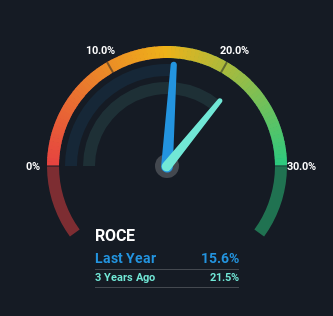Knorr-Bremse (ETR:KBX) May Have Issues Allocating Its Capital
If you're looking for a multi-bagger, there's a few things to keep an eye out for. Typically, we'll want to notice a trend of growing return on capital employed (ROCE) and alongside that, an expanding base of capital employed. Ultimately, this demonstrates that it's a business that is reinvesting profits at increasing rates of return. However, after investigating Knorr-Bremse (ETR:KBX), we don't think it's current trends fit the mold of a multi-bagger.
Understanding Return On Capital Employed (ROCE)
For those that aren't sure what ROCE is, it measures the amount of pre-tax profits a company can generate from the capital employed in its business. Analysts use this formula to calculate it for Knorr-Bremse:
Return on Capital Employed = Earnings Before Interest and Tax (EBIT) ÷ (Total Assets - Current Liabilities)
0.16 = €886m ÷ (€8.2b - €2.6b) (Based on the trailing twelve months to December 2023).
So, Knorr-Bremse has an ROCE of 16%. In absolute terms, that's a satisfactory return, but compared to the Machinery industry average of 11% it's much better.
See our latest analysis for Knorr-Bremse
In the above chart we have measured Knorr-Bremse's prior ROCE against its prior performance, but the future is arguably more important. If you're interested, you can view the analysts predictions in our free analyst report for Knorr-Bremse .
How Are Returns Trending?
On the surface, the trend of ROCE at Knorr-Bremse doesn't inspire confidence. Over the last five years, returns on capital have decreased to 16% from 25% five years ago. However, given capital employed and revenue have both increased it appears that the business is currently pursuing growth, at the consequence of short term returns. And if the increased capital generates additional returns, the business, and thus shareholders, will benefit in the long run.
The Bottom Line On Knorr-Bremse's ROCE
Even though returns on capital have fallen in the short term, we find it promising that revenue and capital employed have both increased for Knorr-Bremse. However, despite the promising trends, the stock has fallen 14% over the last five years, so there might be an opportunity here for astute investors. So we think it'd be worthwhile to look further into this stock given the trends look encouraging.
One more thing, we've spotted 1 warning sign facing Knorr-Bremse that you might find interesting.
While Knorr-Bremse may not currently earn the highest returns, we've compiled a list of companies that currently earn more than 25% return on equity. Check out this free list here.
Have feedback on this article? Concerned about the content? Get in touch with us directly. Alternatively, email editorial-team (at) simplywallst.com.
This article by Simply Wall St is general in nature. We provide commentary based on historical data and analyst forecasts only using an unbiased methodology and our articles are not intended to be financial advice. It does not constitute a recommendation to buy or sell any stock, and does not take account of your objectives, or your financial situation. We aim to bring you long-term focused analysis driven by fundamental data. Note that our analysis may not factor in the latest price-sensitive company announcements or qualitative material. Simply Wall St has no position in any stocks mentioned.

 Yahoo Finance
Yahoo Finance 
